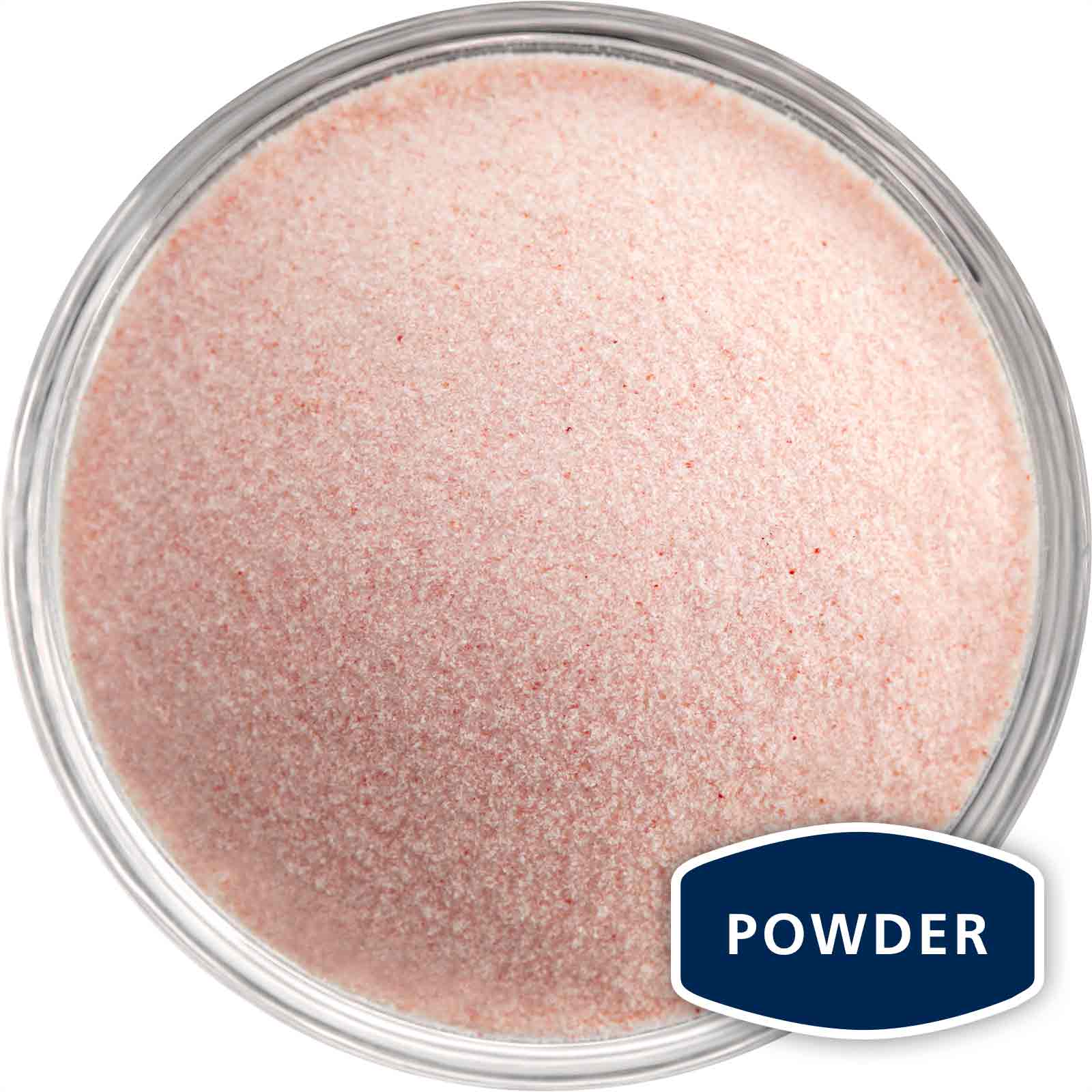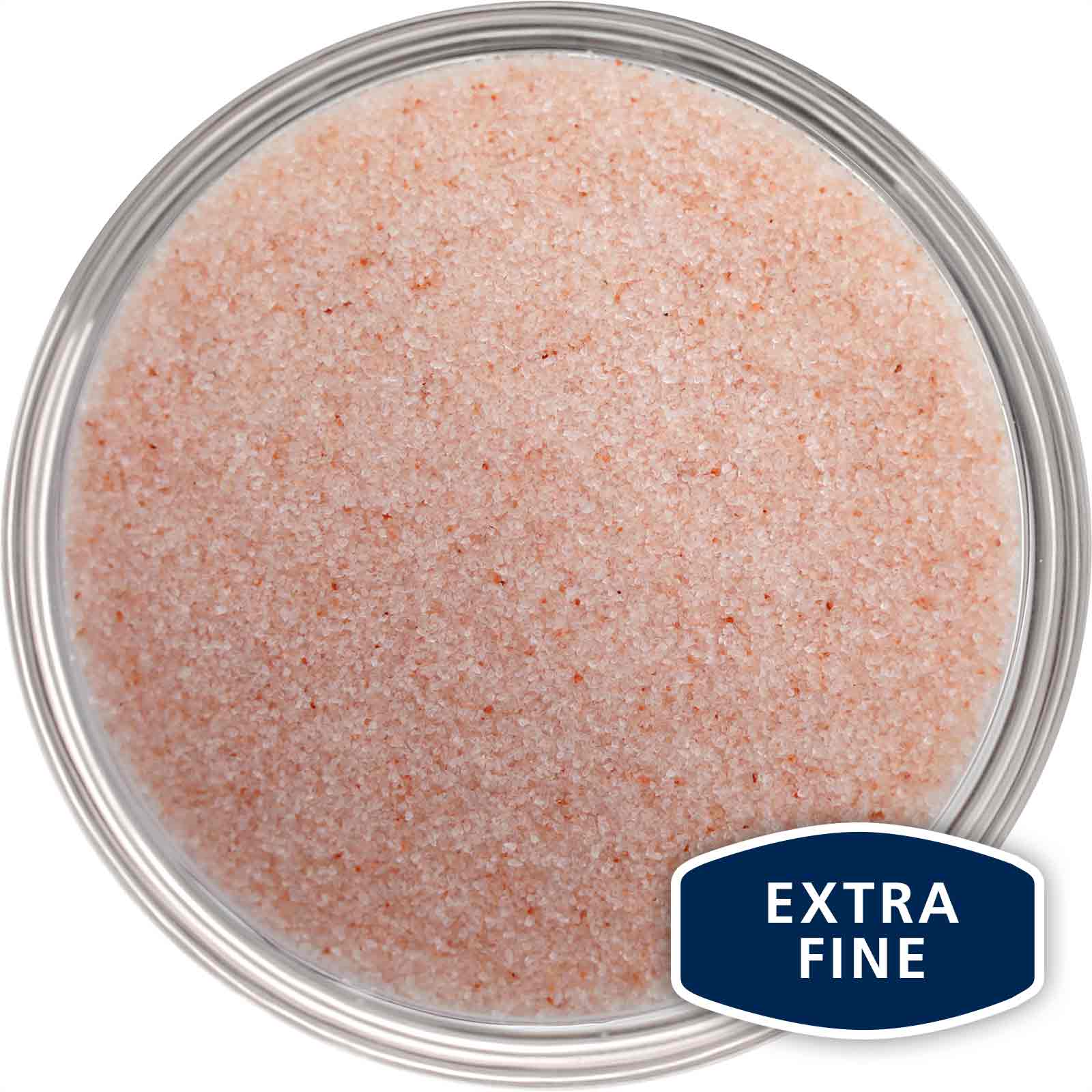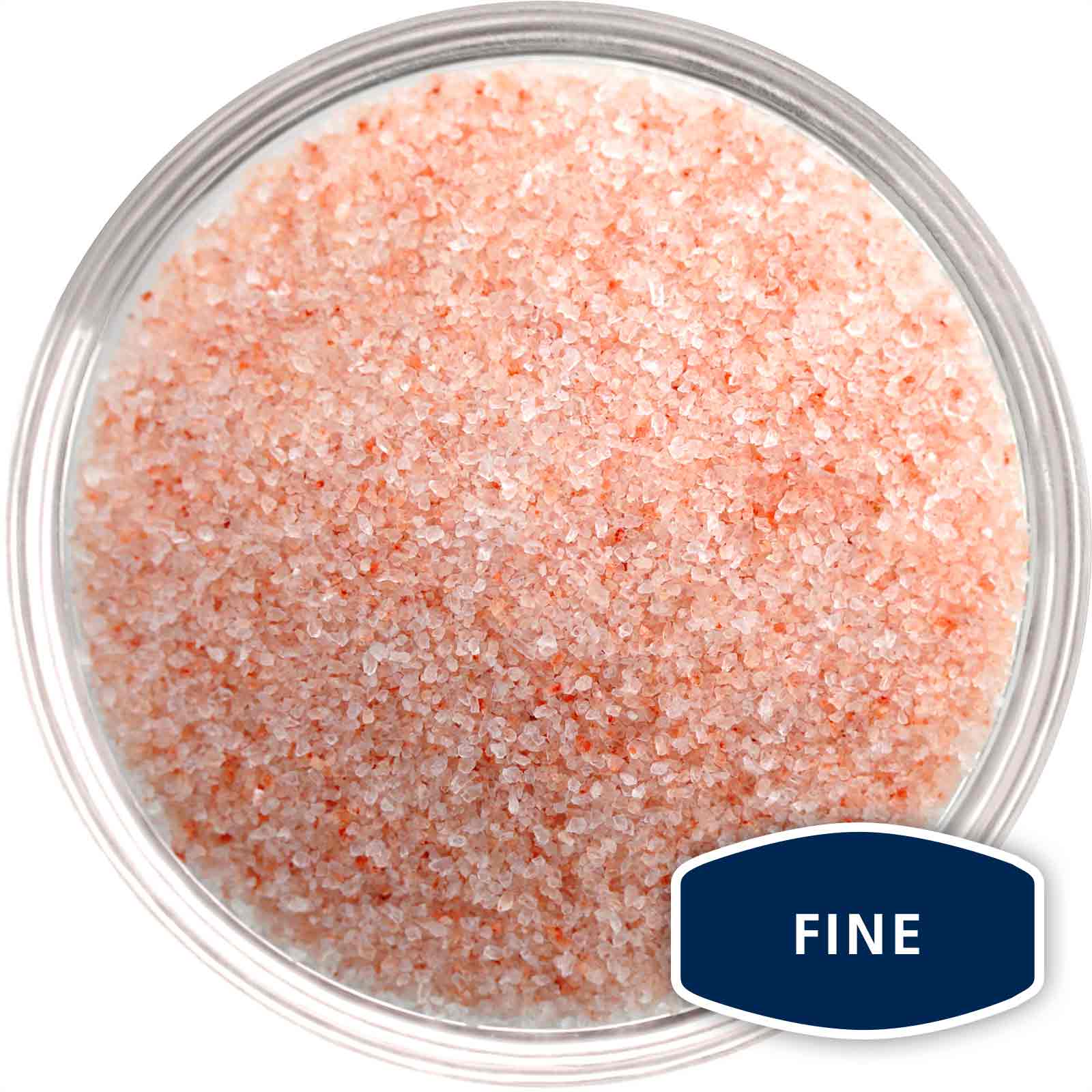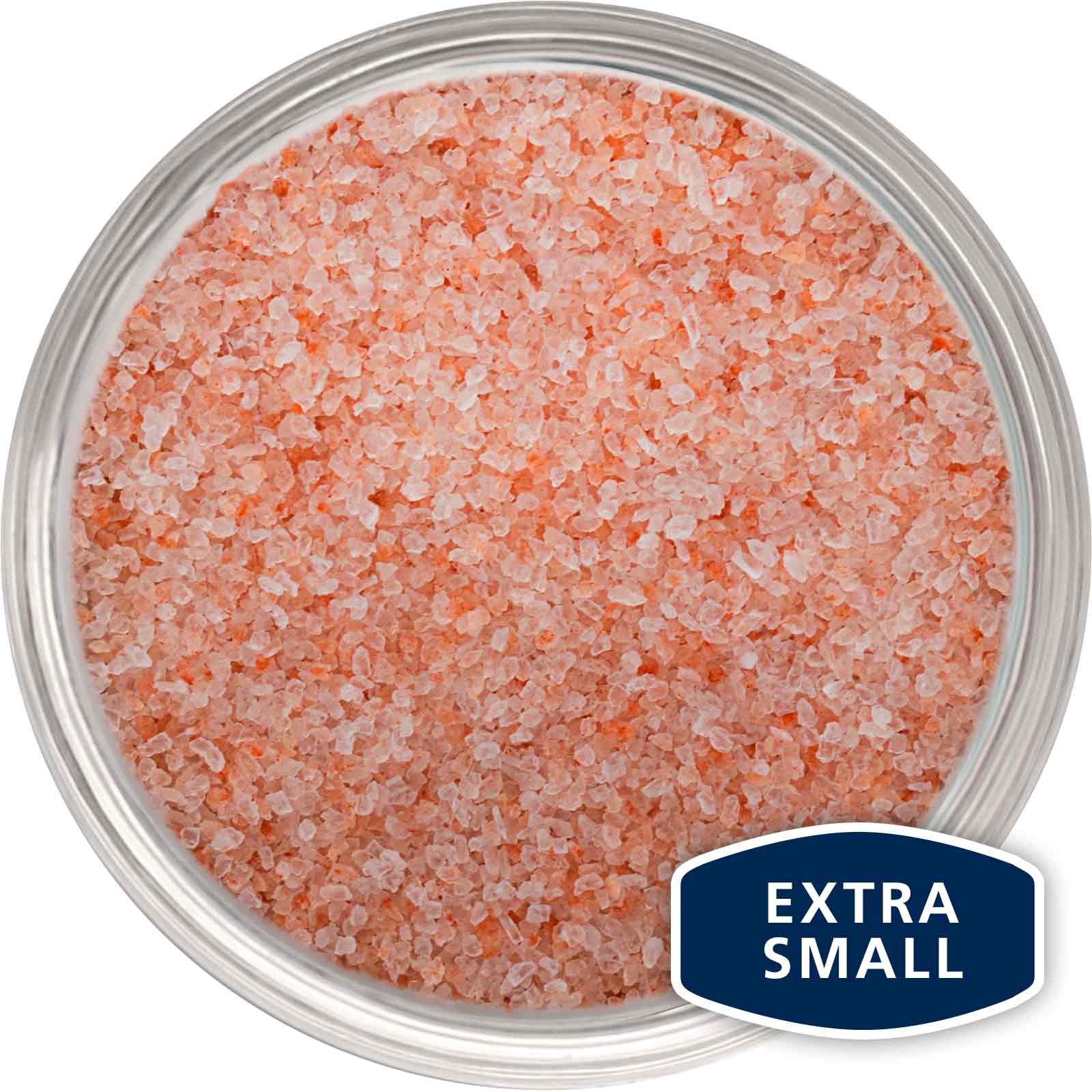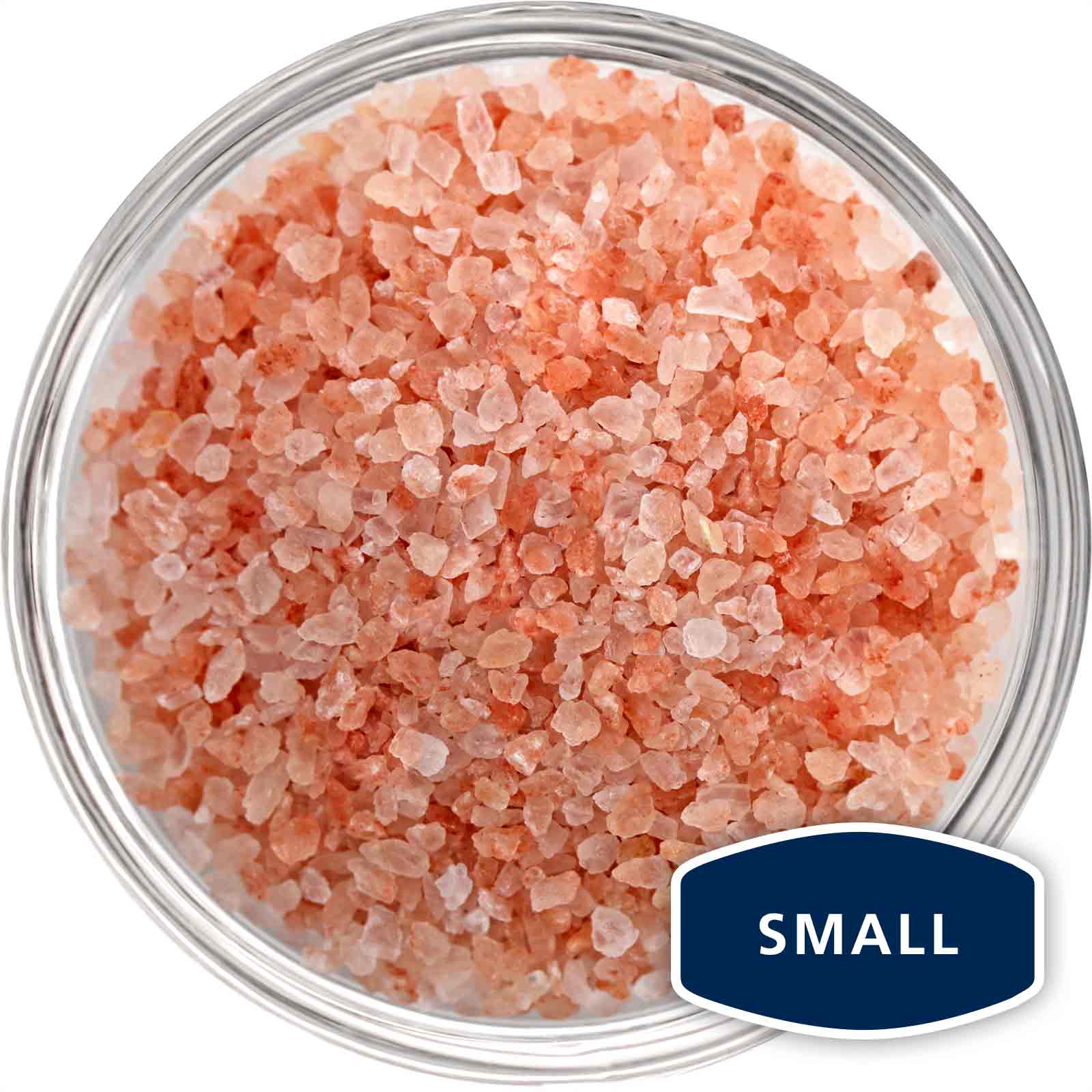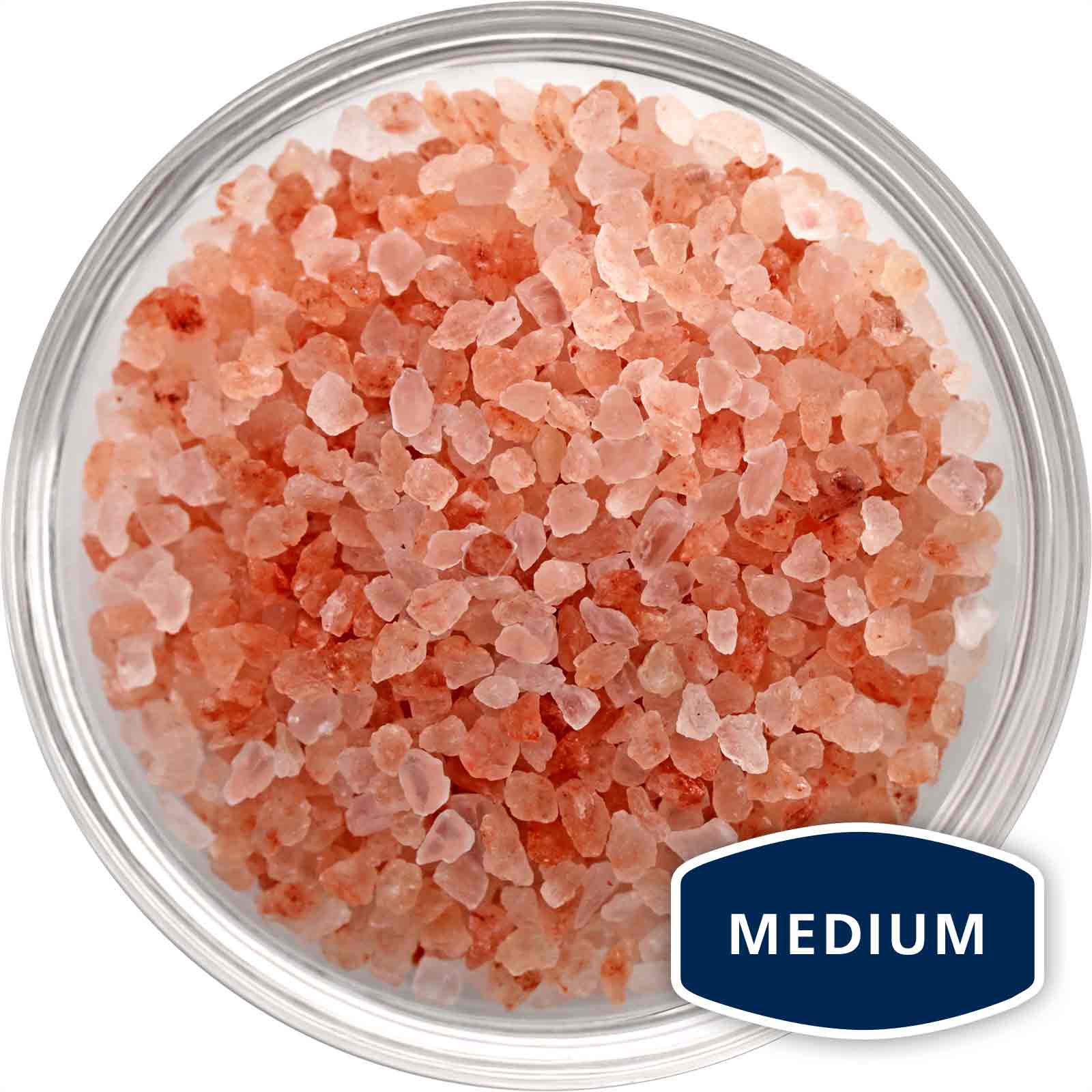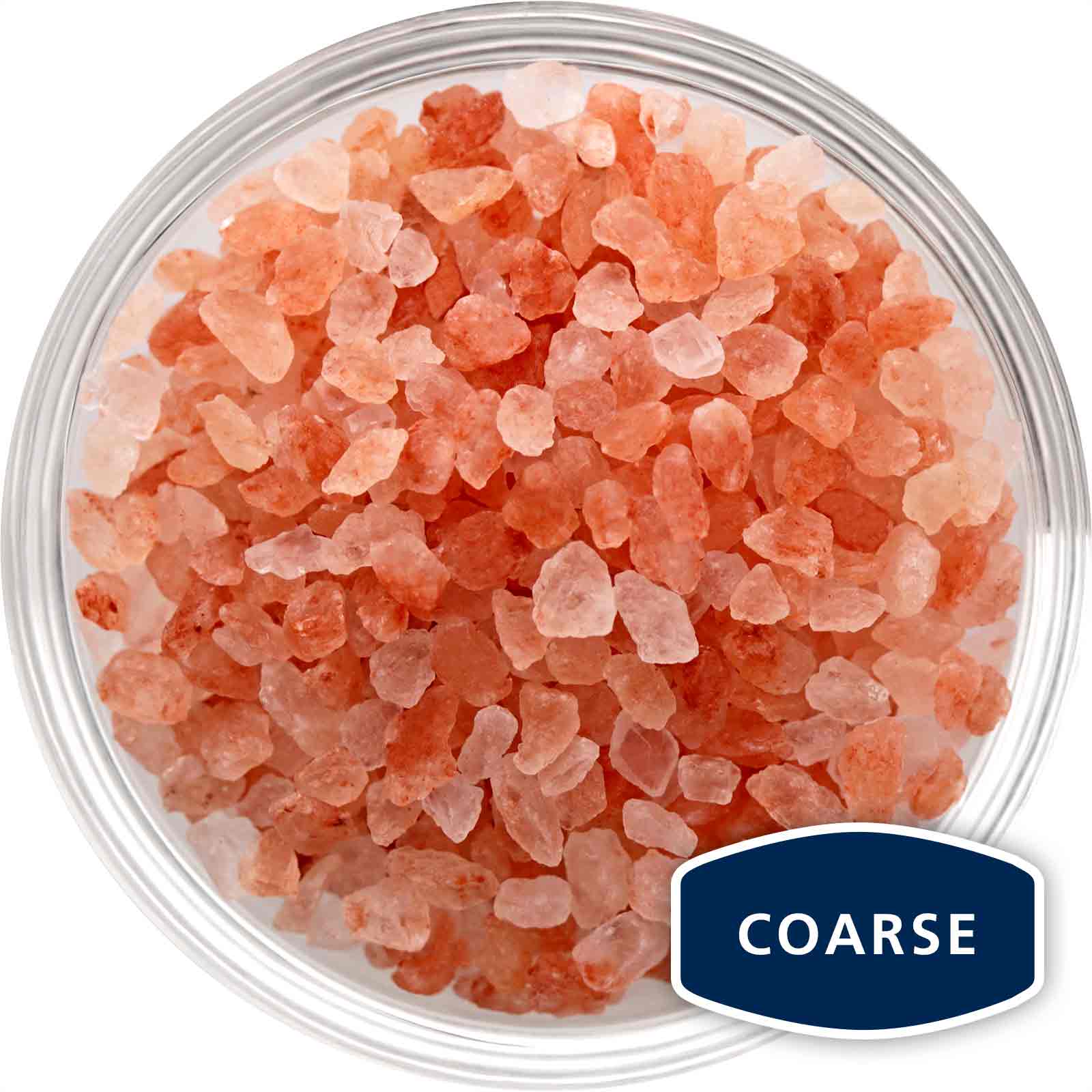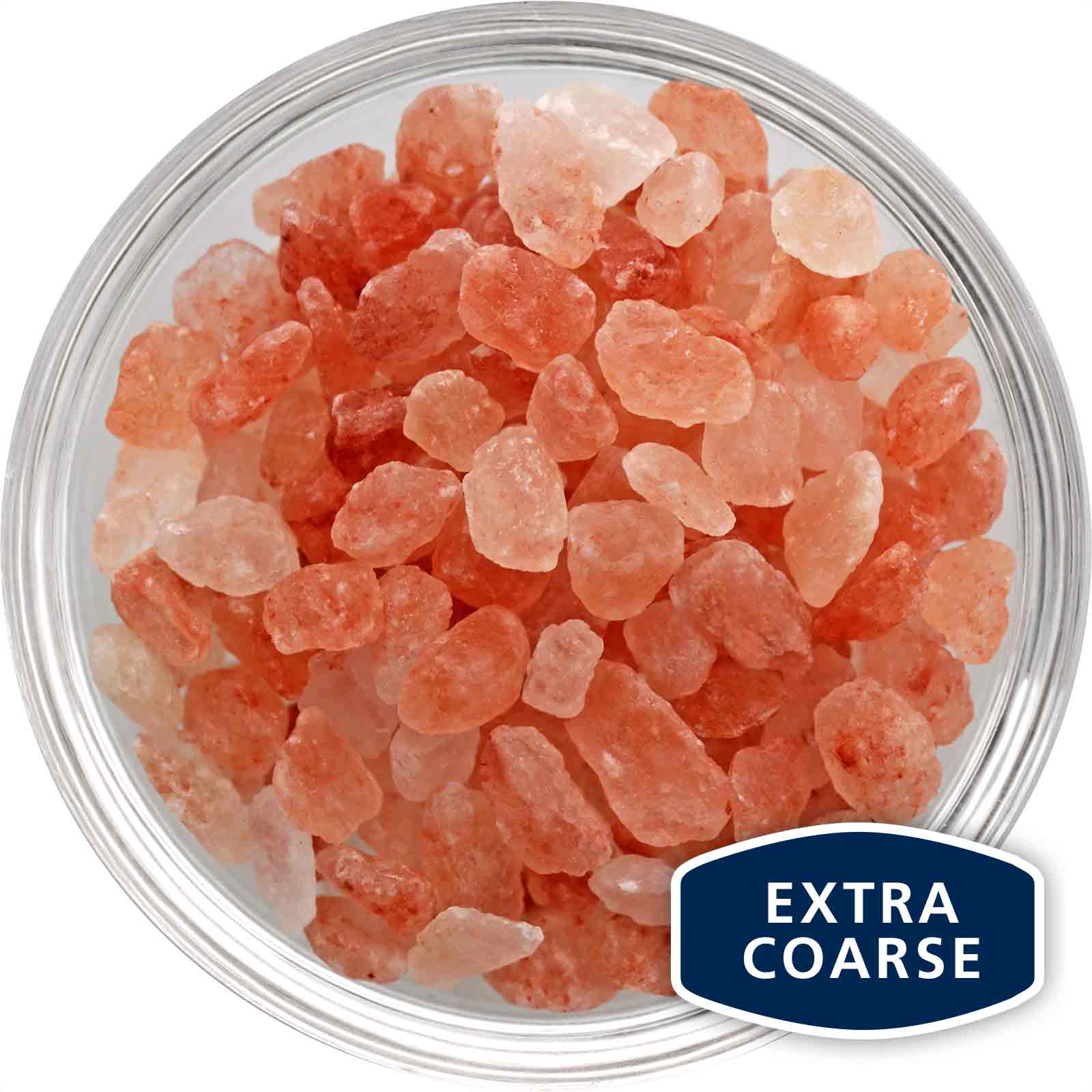Explore Our Grain Sizes
Our Ancient Ocean Himalayan Pink Salt is the highest grade pink mineral salt in the world. Unlike other brands, our Himalayan salt goes through several all-natural proprietary processing methods that guarantee its purity and beauty, and leave its trace minerals intact. We proudly guarantee the quality and authenticity of Ancient Ocean, and offer the most comprehensive selection of consistent grain sizes available to suit a wide variety of manufacturing, processing and retail applications.
Experience the cleanliness, quality and consistency that is SaltWorks Ancient Ocean Himalayan Pink Salt and explore our grain sizes below. Simply drag the blue slider from left to right to scroll from grain size to grain size.
The Anatomy of Himalayan Salt
Himalayan pink salt is the result of an ancient body of water that slowly evaporated, leaving behind a mineral-rich salt bed that was eventually fused with other remaining seabed materials, such as clay and stone. Under tremendous tectonic pressure, these materials were forged together as the Himalayan Mountain range formed, encasing the salt deposits together with clay, stone and other organic matter.
During the excavation process, the raw salt is removed in large boulders and blocks; this raw salt includes those other naturally-occurring components (rock, stone, clay). The salt boulders are broken into smaller pieces for transportation outside the mine, which exposes the salt to additional potential contaminants such as fibers, sticks, rocks, dirt and dust. The salt requires several levels of careful processing to completely remove these other naturally-occurring materials before packaging for consumer purchase and consumption.
Explore Himalayan Salt
This is a slab of raw Himalayan salt. Click each tab at the top to see the different natural elements that are often harvested along with pink salt.
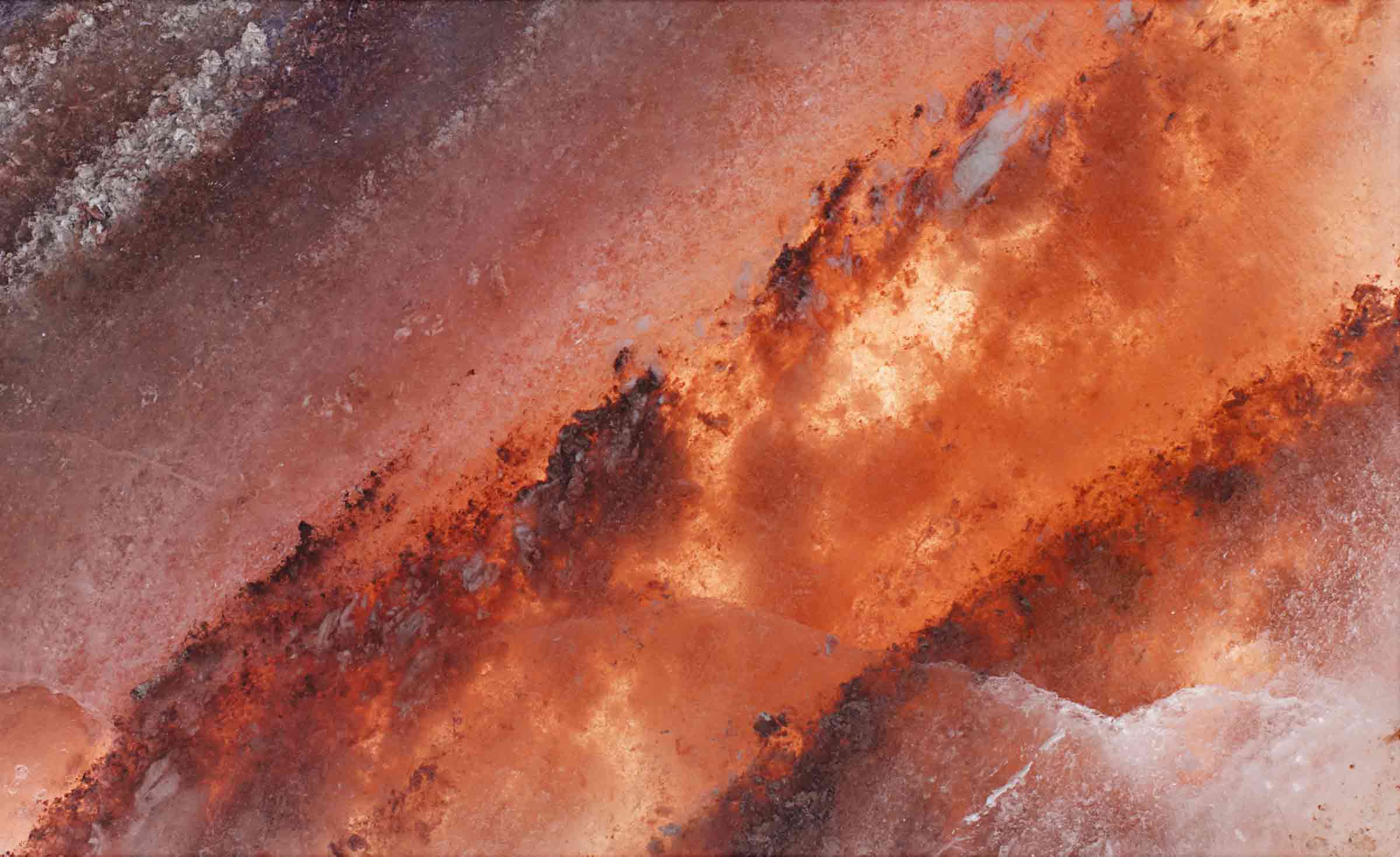
Rocks, clay and salt come in a variety of colors and are fused together at random. As you can see by interacting with this slab, pink clay and pink salt can look very similar to the human eye. This is why careful, detailed processing is required to produce the absolute best and safest salt. Though these elements are similar in color, our Optically Clean ® technology uses the full color spectrum to identify, separate and sort out what is truly salt from what is not, unlike traditional color-sorting equipment commonly used in the industry that views the world in only black and white. Our processes also ensure that darker rocks and different colored clay are separated from the salt, as well, leaving behind the best tasting pink salt.
With the high growth in this sector comes new challenges. Commodity importers unfamiliar with the mineral salt business do not have the unique expertise required and are unable to provide the care and detail needed to properly process Himalayan salt. These importers are flooding the market with significantly lower quality salt, bringing artificially lower prices to suppliers and retailers and selling greater risk (for retailers, manufacturers and ultimately consumers).
SaltWorks remains committed to producing the highest quality, cleanest and safest Himalayan salt available on the market today. We do this by investing in highly-skilled labor, engineering and evolving proprietary technology, machinery and quality processes.
Where Our Himalayan Salt Comes From
All Himalayan pink salt is mined exclusively in Pakistan. The mine where we source our Himalayan salt is a closely-guarded trade secret. We've spent more than a decade building a strong relationship with a reputable, FDA-registered supplier, which has afforded us complete control of the raw salt from the mine to our facility to our customers.
Once the raw salt is removed from the mine, it is securely sealed in our superbags and transported directly to our state-of-the-art salt processing facility in Washington State. To maintain our strict Food Safety and quality standards, all secondary processing and packaging of all of our salt products is always done here, using our proprietary technology, equipment and highly skilled, trained salt experts.
SaltWorks Himalayan Salt
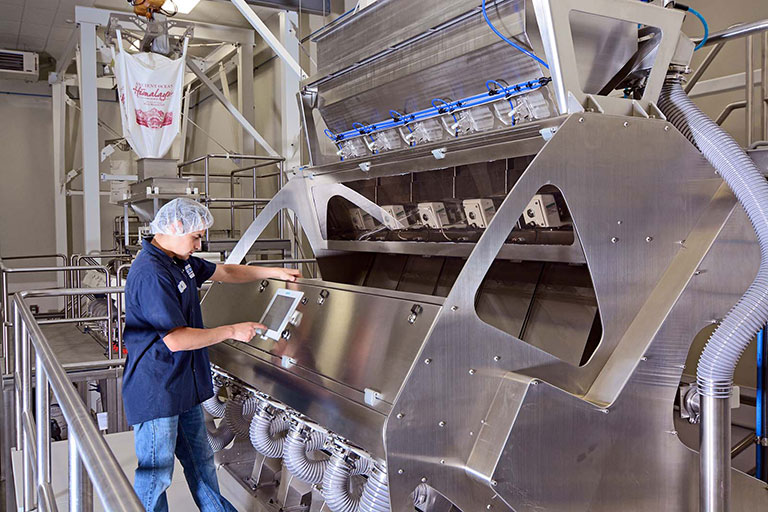 Our state-of-the-art Optically Clean® equipment analyzes salt in free fall using the full color spectrum, ensuring our Himalayan pink salt is the cleanest and most consistent.
Our state-of-the-art Optically Clean® equipment analyzes salt in free fall using the full color spectrum, ensuring our Himalayan pink salt is the cleanest and most consistent.As an SQF facility, SaltWorks has the highest salt quality and food safety standards to comply with the food industry's rigorous safety regulations. Every SaltWorks salt is subject to the same quality and safety standards, protocols and processes.
Our Pink Salt Processing Technology and solutions are the biggest value-add for manufacturers, suppliers, co-packers, retailers and consumers. Food manufacturers and processors are subject to the industry's regulations and third-party auditing processes. Unfortunately, retailers and suppliers are not held to the same level of scrutiny and often don't require the same quality or safety specifications.
Regardless of a customer's position in the industry, we perform the same level of quality and safety processes and provide the same high-quality salt. We never cut corners on our supply chain, equipment, processes or packaging.
Our complex and detailed salt processing system includes sifters, aspirators, the strongest rare-earth magnets in the industry, de-dusters, chemical analysis testing, metal detection, and our exclusive Optically Clean® Technology. These processes scrutinize every grain of salt that enters our facility, removing insoluble matter, foreign materials and crystals that don't meet our strict standards all without ever using chemicals or processing agents that alter the salt.
Unlike older technology commonly used in the industry, SaltWorks advanced Optically Clean equipment uses high-definition cameras to analyze salt crystals in free fall using the full color spectrum. The system detects and then removes materials that blend in with the salt but are actually small rocks, clay particles or other materials, as well as crystals that don't meet color and quality requirements. Anything that doesn't meet our strict guidelines is removed with a burst of air.
Without this extremely advanced color sorter, it is almost impossible to detect the difference between a darker piece of Himalayan salt and a dark piece of clay. When the salt crystal and a piece of clay or stone are roughly the same size and density, these pieces can't be sifted or aspirated out. Without Optically Clean, these particles are left intermingled, reducing the quality, flavor, performance and safety of the salt.
We don't chemically refine our Himalayan Pink Salt in any way; our processes simply remove what is less safe, inedible or not visually appealing.
What's in Lower Quality Himalayan Salt
Not all Himalayan pink salt is created or processed equally. Commodity importers and other suppliers have introduced significantly lower quality Himalayan salt that is poorly processed, often overseas, before being directly imported and sold in the US.
With lower cost and lower quality comes lower food safety. Crudely processed Himalayan pink salt may contain impurities, insoluble and inedible materials such as: metal fragments, pieces of rock or stone, clay particles, dust and powder comprised of finely ground salt and other organic material.
Lower quality Himalayan salt has a less enjoyable flavor profile due to clay particles or dust, and also performs poorly for customers clogging salt shakers and gumming up or even breaking salt grinders.
These different types of insoluble, inedible and undesirable materials require different kinds of equipment to identify and separate them from the salt, which is why we've implemented an extensive, multi-step processing system to effectively and consistently remove them.
For example: dark red pieces of clay and brown pieces of stone that are the same size as salt crystals can't be sifted out. If they're all the same size, they'll meet the same screening requirements.
Older color sorters commonly used in the industry work in greyscale, often observing salt crystals and other materials on a conveyer belt. This equipment can only analyze one side of the material and can't identify as many color variances as our Optically Clean technology.
By analyzing materials in free fall, we're able to scrutinize every facet of each material. This allows us to not only capture and remove non-salt matter, but also identify and reject salt crystals that have small imperfections and stone or clay inclusions. If these inclusions appear on only one side or a small portion of the salt grain, these crystals might otherwise pass an inspection by less advanced processing equipment.
After mining, Himalayan salt naturally contains dust. This powder is a compilation of finely ground salt mixed with other finely ground matter. Lower quality and poorly processed Himalayan salt contains dust. It often sinks to the bottom of a container, and is easily identified during simple visual and taste tests.
Unfortunately, without proper chemical analysis or de-dusting, it's impossible to know what that dust powder contains or fully separate it from the salt. There's also no way to clean powder. Every single grain size of Ancient Ocean Himalayan Pink Salt is sifted and de-dusted to ensure that only pure, consistent (and dust-free) salt grains are packaged and delivered to our customers.
What the powder is comprised of can negatively impact the salt's flavor. It is also much more susceptible to clumping, which can reduce pink salt's performance in salt shakers and grinders.
We guarantee the authenticity and cleanliness of our Powder Grain Himalayan Salt, because we make it. Our Powder grain isn't simply sifted or separated from the raw salt we receive from our supplier.
We only sell powdered pink salt that was specifically created during the granulating process in our facility. We take a pristine, cleaned Fine grain pink salt that has been thoroughly processed and then custom granulate it to a very fine, powder-like consistency.
Our proprietary processing equipment ensures that quality and consistency of all of our salts. Pictured below are two integral parts of our Salt Processing Capabilities: Our SWECO separators and MPE Gran-U-Lizer.
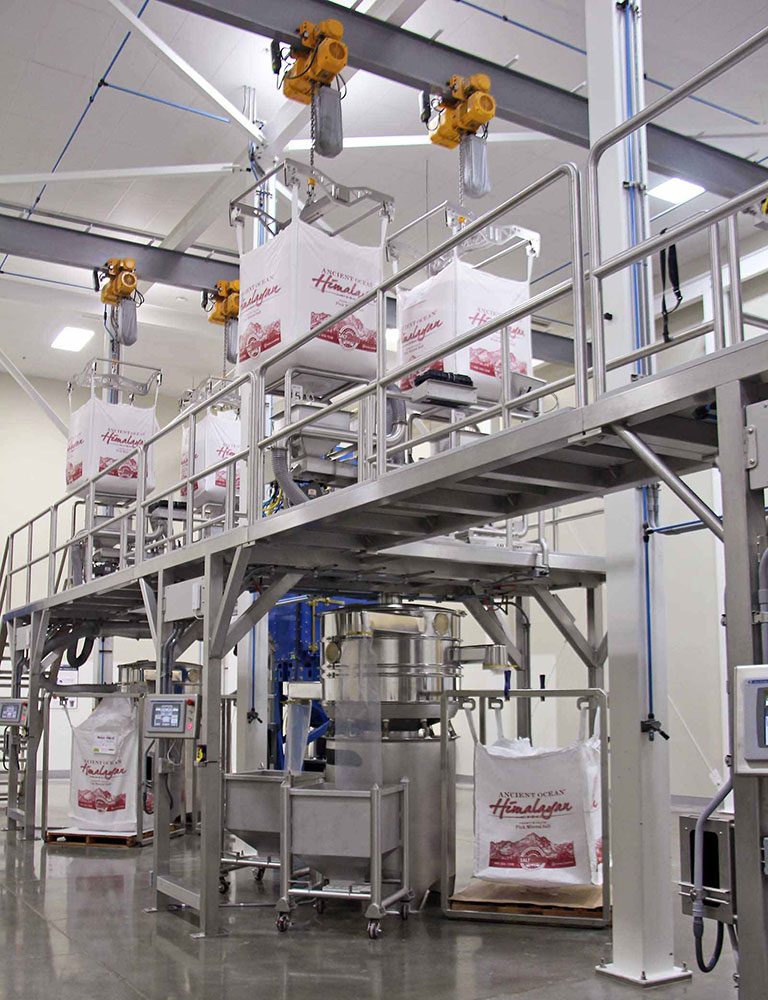 In our state-of-the-art sifting room, we aspirate Himalayan pink salt to remove anything that is lighter than the salt itself (like fibers and dust), run the salt through rare-earth magnets, and then sift the grains to separate out other non-salt materials and sort the grains using custom sieves to ensure consistent sizing.
In our state-of-the-art sifting room, we aspirate Himalayan pink salt to remove anything that is lighter than the salt itself (like fibers and dust), run the salt through rare-earth magnets, and then sift the grains to separate out other non-salt materials and sort the grains using custom sieves to ensure consistent sizing.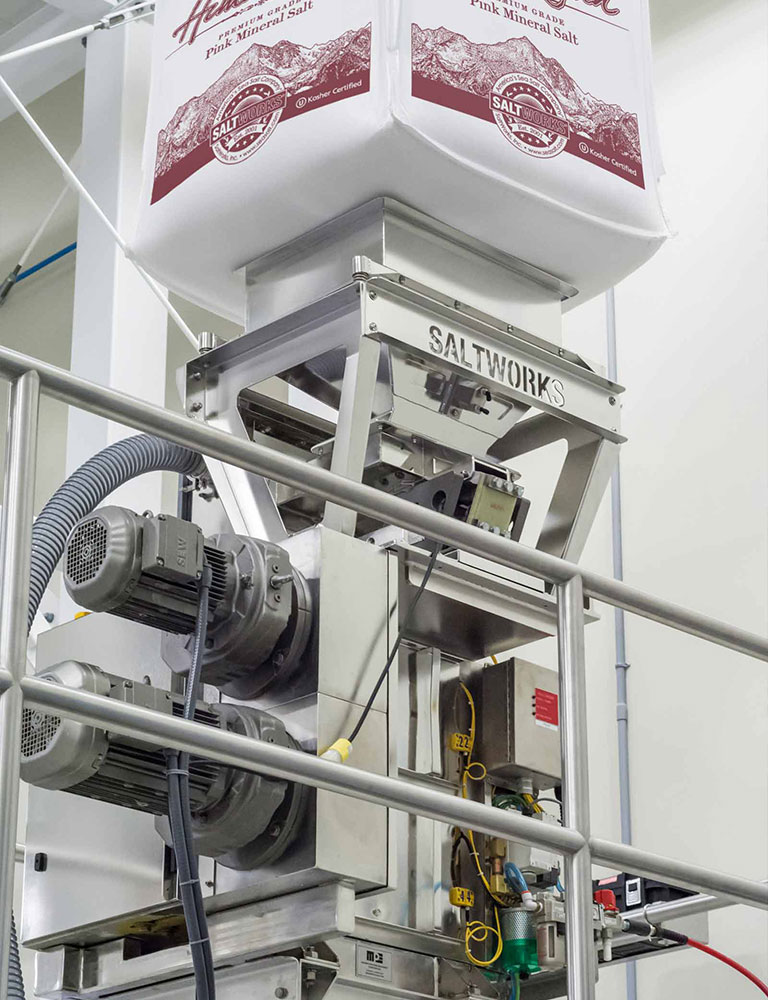 Our custom-built MPE grinder granulates cleaned and processed salt into a variety of exacting grain sizes, including our very fine Powder grain. The most sophisticated and accurate particle reducer in the industry maximizes our grind results to ensure we produce the most consistent grain sizes for our customers.
Our custom-built MPE grinder granulates cleaned and processed salt into a variety of exacting grain sizes, including our very fine Powder grain. The most sophisticated and accurate particle reducer in the industry maximizes our grind results to ensure we produce the most consistent grain sizes for our customers.Salt Quality Checklists
We encourage all buyers to ask potential suppliers about their quality benchmarks, facilities, and how and where their pink salt is processed. It's easy to see and taste the differences between high-quality and poorly processed Himalayan salt.
Questions to Ask Your Salt Supplier
Buyers should ask if the raw salt supplier is:
Registered with the FDA?
In compliance with new FSMA regulations?
What additional safety and quality standards and certifications do they hold? (Such as: Not employing child labor, providing fair wages, providing healthcare and education to the miners, etc.)
Additionally, SaltWorks encourages buyers to ask if the raw salt is "single source" from one mine and a single, trusted and reputable raw salt supplier. Single-source ensures consistent quality and supply.
Buyers should ask the following about salt processing and packaging facilities:
How is the salt transported to the facility?
Where is the salt processed? (Is the facility located in the US or overseas?)
Is the facility third-party audited? By what certifying body?
What food safety certifications do you hold? Does the facility meet GFSI (the Global Food Safety Initiative) and HACCP (Hazard Analysis and Critical Control Points) requirements?
What GMPs (Good Manufacturing Practices) have been implemented?
How we perfect
SaltWorks encourages buyers to ask about the processes performed, and grade potential suppliers based on the processes (or lack thereof), as these directly affect the quality of the salt.
SaltWorks Processing Steps Include:
Optical Color Sorting: SaltWorks has four custom-designed color sorters that can identify and remove even the most elusive inclusions. Our proprietary, exclusive Optically Clean technology detects particles that mimic the appearance of salt (like clay, stone and rock) as well as salt crystals that have inclusions of rock or clay, or may otherwise be less desirable, and removes them with a jet of air. As a built-in redundancy, all salts are processed through our Optically Clean technology twice.
Rare-Earth Magnets: SaltWorks has the strongest rare-earth magnets in the industry; this multi-point process removes any ferrous metal and magnetic contamination.
Aspiration: Removes objects lighter than the salt, such as plant matter, fibers, wood and other undesirable materials.
De-Dusting: Removes any dust created during transportation, as well as processing, including residue from granulation.
Metal Detection: In addition to rare-earth magnets, we conduct a final metal detection step to ensure that the processed and packaged salt is free of ferrous and nonferrous metals.
Sieving: SaltWorks offers the most expansive selection of grain sizes, which are specially sieved to exacting sizes, ensuring consistency from order to order.
Packaging: SaltWorks designs many of its containers in-house; our bulk packaging is dust-proof and moisture-proof. All salts are packaged in our state-of-the-art facility in the US.
Salt Visual and Taste Tests
SaltWorks encourages buyers and consumers to conduct their own simple visual inspections and taste tests to determine the quality of the salt.
By spreading salt out on a lightly colored surface (a white or stainless steel background works best), buyers can identify visual and tactile differences between salt crystals, and visually identify inclusions that may not be salt.
Color: Correctly processed high-quality Himalayan salt will range in color from varying shades of pink to light red. When backlit, every crystal should be slightly translucent. Any solidly opaque particles are not salt.
Inclusions (insoluble materials): It's easy to identify fibers, clay or stone particles, and lesser quality salt grains that may have stone inclusions. Grains that are opaque red, white, gray and brown are inedible or insoluble materials. These inclusions can negatively impact the flavor of the salt and hinder the salt's performance in grinders and mills by damaging the grinding mechanisms.
Dust: Powder and dust is common in lower quality Himalayan salt. Unfortunately, there's no effective way to "clean" dust. Without proper chemical analysis testing, it can't be identified as solely finely-ground salt (without any other finely-ground matter included). SaltWorks sifts out raw salt dust powder, and all salts are also de-dusted prior to packaging to remove any excess dust created during processing.
Flavor: The flavor should be salt-forward with a slight but distinct minerality. A clay-like flavor and gritty texture indicate a lower-quality salt that includes impurities.
The lowest quality salt may contain fine dust, dirt, plastic or other foreign particles. We encourage you to compare quality and not just price. You'll see the quality and taste the difference of SaltWorks Himalayan Pink Salt.
We've dedicated our lives to bringing the best tasting, cleanest salt to our customers worldwide. We're passionate about perfecting salt naturally while preserving the flavor profiles, textures and characteristics that make each salt unique.

